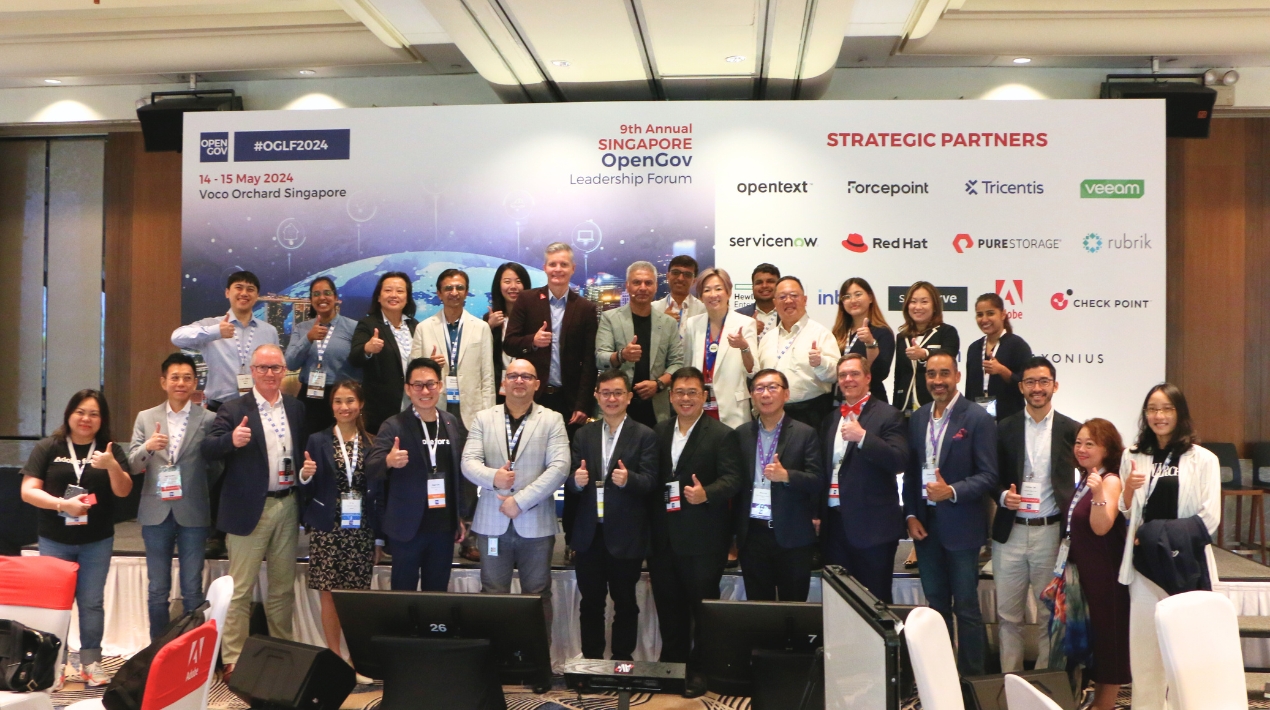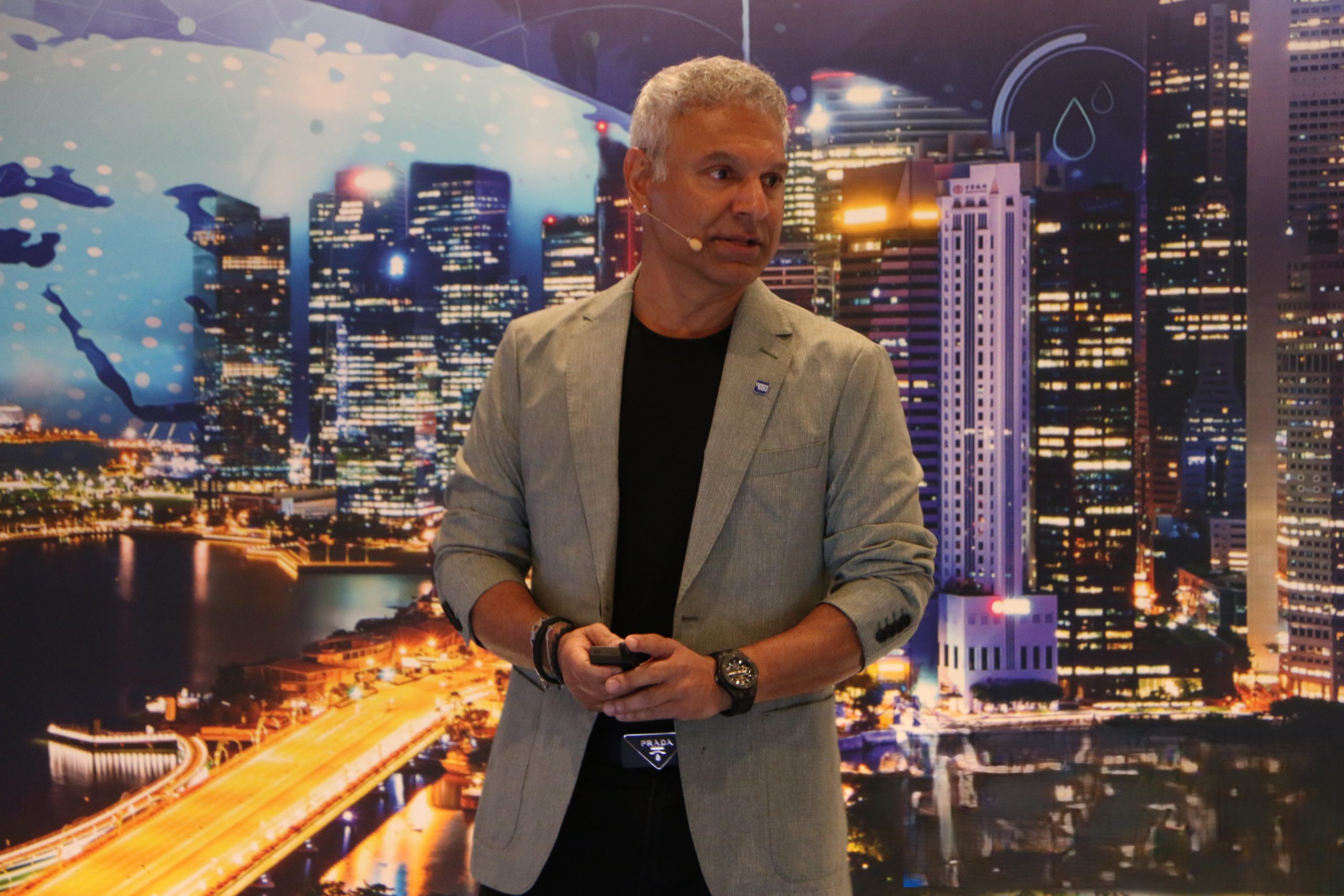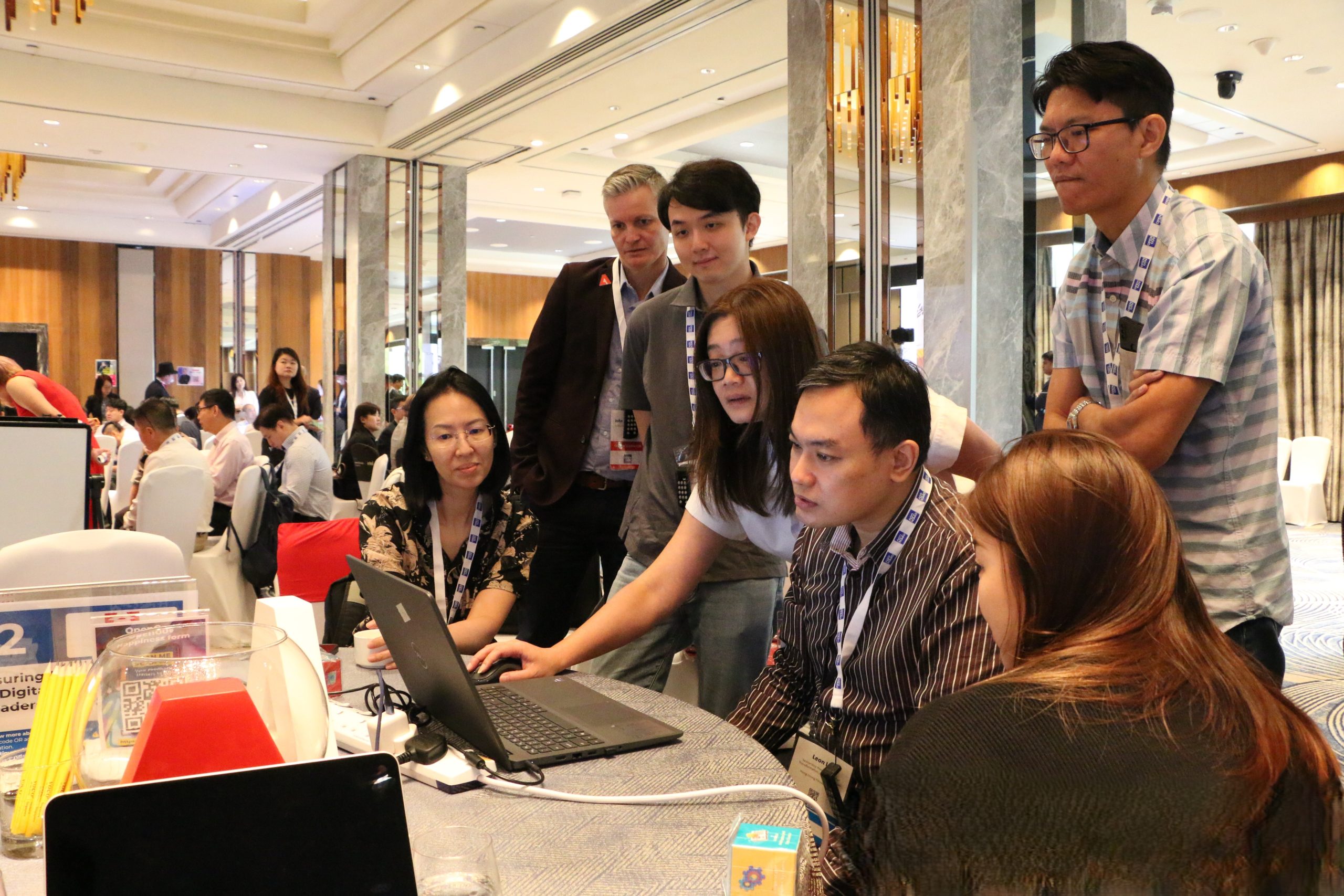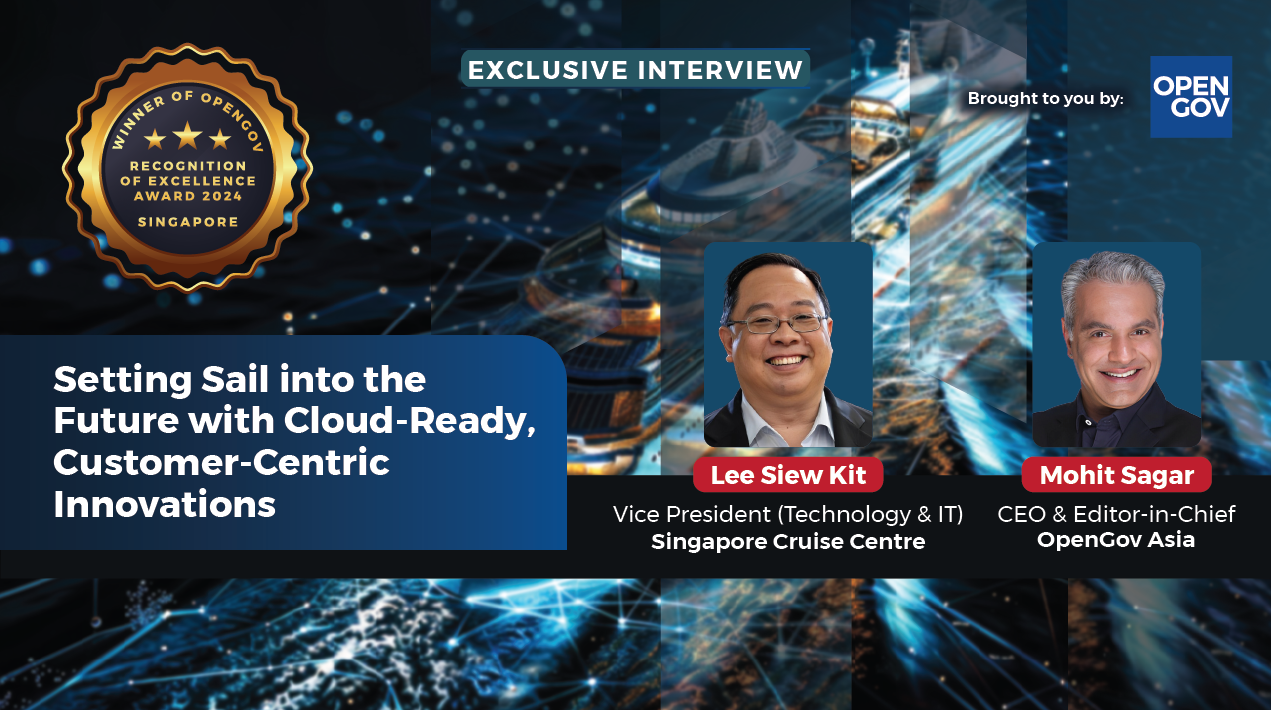
This is Day 2 of The 9th Annual Singapore OpenGov Leadership Forum 2024. You can read about Day 1 here.
The rapid advancement of digital technologies is reshaping the landscape of governance, ushering in a future where artificial intelligence, ubiquitous connectivity, and a focus on public empowerment are paramount. Traditional bureaucratic processes, characterised by long queues and paper forms, are giving way to a new era of efficiency and accessibility.
 Imagine a world where AI-powered chatbots are available 24/7 to guide citizens through complex government procedures, and personalised dashboards provide easy access to relevant services and benefits. Here, real-time data analysis enables policymakers to make informed decisions based on citizen needs, fostering a more responsive and citizen-centric governance model.
Imagine a world where AI-powered chatbots are available 24/7 to guide citizens through complex government procedures, and personalised dashboards provide easy access to relevant services and benefits. Here, real-time data analysis enables policymakers to make informed decisions based on citizen needs, fostering a more responsive and citizen-centric governance model.
The evolution toward digital governance entails more than just technological advancements; it necessitates instilling confidence through, inclusivity, transparency and safety. To achieve this, robust cybersecurity measures are imperative to protect data and maintain public trust. Furthermore, embracing a comprehensive and inclusive approach is essential, ensuring broad access to technology to bridge the digital gap and facilitate equal participation for all citizens in this era of digital transformation.
The digital revolution is a powerful force for change, enabling unprecedented connectivity, collaboration, and innovation on a global scale. It transcends geographical boundaries, allowing individuals worldwide to connect and collaborate in ways never before possible.
Digital technologies empower nations to address pressing global challenges, such as climate change, healthcare, education, and economic development. By pooling resources, sharing knowledge, and co-creating innovative solutions, lives can be transformed and a more sustainable future for all can be shaped.
 Further, the democratisation of access to information and opportunities is a key outcome of the digital revolution. Online education, remote work opportunities, and e-commerce platforms are breaking down traditional barriers and opening up new avenues for economic empowerment and social mobility. However, it’s essential to address the challenges and risks that come with these advancements, such as cybersecurity threats, privacy concerns, digital divides, and inequalities.
Further, the democratisation of access to information and opportunities is a key outcome of the digital revolution. Online education, remote work opportunities, and e-commerce platforms are breaking down traditional barriers and opening up new avenues for economic empowerment and social mobility. However, it’s essential to address the challenges and risks that come with these advancements, such as cybersecurity threats, privacy concerns, digital divides, and inequalities.
The digital revolution holds immense potential to revolutionise governance, making it more connected, inclusive, and sustainable. By embracing digital technologies and fostering a culture of innovation and transparency, governments can pave the way for a brighter future for all citizens.
The 9th Annual Singapore OpenGov Leadership Forum 2024 on 14-15 May 2024 at Voco Orchard Singapore brought together digital leaders from Singapore’s private and government sectors, aiming to drive discussions and collaborations on digital transformation, innovation, and cybersecurity in Singapore. The forum provided a platform for leaders to share insights, best practices, and strategies for leveraging technology to enhance public services, improve citizen engagement, and drive economic growth.
The forum’s speakers included industry experts, government officials, and thought leaders who shared their experiences and expertise in driving digital innovation and transformation. It also featured interactive sessions, panel discussions, and networking opportunities, enabling participants to exchange ideas and build relationships.
The event highlighted Singapore’s commitment to embracing digital technologies to enhance governance and improve the lives of its citizens. By fostering collaboration between the public and private sectors and promoting a culture of innovation and cybersecurity, Singapore aims to position itself as a global leader in digital governance and smart city initiatives.
Welcome Address

Mohit Sagar, CEO and Editor-in-Chief at OpenGov Asia, explained that Singapore is a symbol of innovation and progress, having earned the title of Asia’s smartest city. Under the leadership of innovative leaders, Singapore has embraced digital transformation across all sectors, establishing itself as a global leader in smart city initiatives.
The city-state boasts world-class infrastructure, including intelligent transit systems, sustainable energy solutions, and effective urban planning initiatives. By leveraging sophisticated technologies such as artificial intelligence and the Internet of Things, Singapore enhances public services, optimises resource allocation, and improves the quality of life for its inhabitants.
Singapore’s smart city efforts are distinguished by a citizen-centric approach that values inclusivity, accessibility, and social balance. By fostering innovative partnerships between the public and private sectors, Singapore continues to push the boundaries of innovation and sustainable growth, setting an example for other Asian and global cities. This has garnered international recognition for its achievements in smart city innovation, positioning it at the forefront of the worldwide urbanisation movement.
In essence, Singapore’s drive to become Asia’s smartest city demonstrates the transformative power of technology and strategic governance in building a brighter, more sustainable future for metropolitan centres worldwide.
Adapting to the complexities of the global landscape through technology is crucial for any organisation operating in today’s digital environment. A solid fundamental IT strategy provides a roadmap for using technology to achieve corporate goals effectively and economically. It serves as a guide for risk management, resource allocation, and decision-making across all departments.
The first step in developing a sound IT strategy is a thorough understanding of the organisation’s aims and objectives, including both long-term goals and immediate objectives in terms of expansion and innovation. By aligning IT projects with these objectives, organisations can ensure that their technology investments yield measurable benefits and enhance overall performance.
A robust IT strategy also incorporates adaptation and flexibility to cope with the ever-changing business environment and technological advancements. This involves conducting regular evaluations and making necessary adjustments to keep the strategy relevant and effective over time.
 An effective IT strategy considers the organisation’s unique opportunities, threats, weaknesses, and strengths. It identifies areas where technology can boost productivity, resolve operational issues, or provide a competitive edge. Understanding the internal and external factors that influence the business allows organisations to create targeted IT initiatives with the most significant impact.
An effective IT strategy considers the organisation’s unique opportunities, threats, weaknesses, and strengths. It identifies areas where technology can boost productivity, resolve operational issues, or provide a competitive edge. Understanding the internal and external factors that influence the business allows organisations to create targeted IT initiatives with the most significant impact.
In the age of digital transformation, visibility has emerged as a strategic necessity for businesses striving to thrive amidst complexity and competition. Those who prioritise visibility and invest in the necessary technology, processes, and cultural initiatives create new opportunities, drive innovation, and deliver more excellent value to customers and stakeholders.
Endpoint management plays a crucial role in ensuring the security, efficiency, and smooth operation of digital infrastructure. This involves implementing robust security measures, enforcing policies, managing updates, monitoring performance, and supporting remote management. Endpoint management is essential for realising the full potential of visibility-driven transformation.
Strict AI regulations are necessary to guarantee the ethical and responsible application of AI technologies, both internally within enterprises and externally at the governmental level. Internally, organisations must have strong policies for analytical transparency, data privacy, and bias reduction to protect themselves from potential risks.
“Externally, regulatory agencies must establish clear guidelines governing AI research, application, and accountability, holding companies responsible for the societal impacts of their AI systems. Implementing stringent regulations can promote fairness, build trust, and mitigate the risks associated with the proliferation of AI,” Mohit advocates.
The importance of strategic technology adoption and governance in driving innovation and sustainability cannot be overstated. By embracing these principles, organisations can navigate the complexities of the modern digital landscape and achieve sustainable growth.
Technology Case Study: Getting AI Right

Keith Nelson, Industry Senior Strategist for Global Public Sector at OpenText, underscores the profound impact of AI on the public sector, emphasising its role in revolutionising decision-making, service delivery, and operational efficiency, effectively addressing complex challenges and yielding superior outcomes for citizens.
AI offers immense promise for the public sector, presenting governments with a unique opportunity to shape national priorities, drive strategic investments, and establish regulatory frameworks for AI implementation.
Governments are increasingly utilising AI to craft more effective policies, make informed decisions, enhance citizen engagement, and elevate service quality. However, realising the full potential of AI in the public sector is a complex endeavour, fraught with risks and limitations that necessitate careful consideration.
While governments stand to reap significant benefits by leveraging AI to redefine policy and service methodologies, it’s imperative to approach the pervasive hype surrounding AI with a critical mindset.
Often, exaggerated claims about emerging technologies can obscure their practical applications. Therefore, a comprehensive understanding of AI is essential for enabling policymakers and civil servants to assess its relevance and effectiveness in achieving their organisational objectives.
Keith reiterates that AI is not merely a technological innovation but a strategic asset capable of tackling intricate challenges and delivering superior outcomes for citizens. At OpenText, AI is instrumental in reshaping the public sector landscape, with its transformative impact on decision-making, service delivery, and operational efficiency.
“One of AI’s key advantages in the public sector is its ability to help governments set national priorities, make strategic investments, and establish regulatory frameworks,” Keith explains. “AI can also revolutionise how policies and services are developed and delivered, leading to more effective and responsive governance.”
Despite AI’s transformative potential, it is crucial to approach its adoption with a critical mindset. The hype surrounding AI can sometimes overshadow its practical applications, making it essential for policymakers and civil servants to have a thorough understanding of AI to make informed decisions about its implementation.
Technology Case Study: Measuring Progress Towards Digital Government Leadership in Singapore

John Mackenney, Practice Director of the Digital Strategy Group in APAC at Adobe, recognises Singapore’s steady progress in realising its Smart Nation goals, especially in improving digital public services, as evidenced by Adobe’s research.
Launched in 2014, the Smart Nation initiative is dedicated to improving lives, fostering community bonds, and creating economic opportunities. It expands on previous efforts like the ‘e-government’ campaign, emphasising digitalising public services to enhance Singapore’s economic competitiveness.
The initiative has revolutionised Singapore’s public administration, prioritising strategic national projects to drive digital and intelligent technology adoption. Through investments in infrastructure and shared open platforms, the government has been able to foster collaboration among businesses and individuals.
Singapore is also actively developing the Punggol Digital District (PDD) as an innovative hub for work and life. Envisioned as a collaborative ecosystem, the PDD seeks to foster interactions among innovators, businesses, and the community to bring ideas to fruition.
“Through initiatives like the PDD, Singapore is paving the way for responsible and inclusive adoption of technology in the public sector, setting a global benchmark for leveraging cutting-edge technology for societal benefit,” John agrees.
However, he stresses the importance of continuing to assist citizens in navigating the intricate digital environment and verifying information credibility. Mackenney advocates for the integration of innovative technologies such as AI within the public sector to enhance citizen experiences, foster inclusivity, and elevate service delivery standards.
“Artificial Intelligence plays a pivotal role in transforming the public sector, offering immense potential for governments to enhance public services, streamline operations, and elevate citizen experiences,” he believes. “Governments wield a unique ability to establish national priorities, allocate investments, and set regulations for AI, enabling them to redefine how policies and services are developed and delivered.”
Integrating AI can revolutionise service delivery in the public sector, making it more responsive, efficient, and tailored to individual needs. This technology can augment existing systems across various domains, including law enforcement, elections, transportation, public finance, and government administration.
 To substantiate his position, John cited machine learning algorithms capable of analysing historical crime data to predict future crime hotspots, aiding law enforcement agencies in resource allocation. Likewise, AI systems can optimise and improve the precision of signature matching during elections, thereby lightening the workload for election workers.
To substantiate his position, John cited machine learning algorithms capable of analysing historical crime data to predict future crime hotspots, aiding law enforcement agencies in resource allocation. Likewise, AI systems can optimise and improve the precision of signature matching during elections, thereby lightening the workload for election workers.
Incorporating AI into the public sector can drive cost efficiency, elevate citizen satisfaction, and advance societal well-being. It can enable personalised, predictive and preventive services in critical areas such as education, transportation planning and firefighting. This saves money directly for the government and enhances productivity for citizens and private entities, thereby generating an economic multiplier effect.
The digital economy encourages firms to invest in technology and talent, driving growth internationally, while a digitally empowered society allows individuals to develop their skills, participate in national transformation and stay abreast of the latest digital advancements for a more enriching life.
However, challenges persist, particularly in integrating AI into the public sphere, raising important questions about information safety, authenticity, and ethical considerations, especially when fostering widespread participation in a Smart Nation. To address these challenges proactively, Singapore is redoubling efforts to strengthen cybersecurity and safeguard data privacy.
John acknowledges that while adopting AI in the public sector offers immense potential, it must be weighed against significant considerations and risks. In response, the Organisation for Economic Co-operation and Development (OECD) established the OECD AI Principles in 2019 to address these challenges. These principles ensure that AI systems embody human-centred values, including fairness, transparency, explainability, and accountability.
As Singapore continues its journey towards digital leadership, the integration of AI stands as a transformative force poised to revolutionise citizen experience. With the potential to enhance responsiveness, efficiency, and customisation of services, AI offers a pathway to unlock new levels of citizen satisfaction and societal well-being.
“Despite the myriad challenges, Singapore can navigate this journey by adhering to established international guidelines and drawing from its own experiences,” John concludes. “By doing so, it can harness the full potential of AI to shape a future where technology serves the common good and enhances the quality of life for all citizens.”
Technology Case Study: Digital Excellence: Harnessing AI to Support Continuous Innovation

Kal Marshall, Regional Vice President for Public Sector, APJ at Appian agrees that artificial intelligence (AI) is a significant enabler in today’s business landscape, offering numerous opportunities for enhanced efficiency, time savings, and advanced analytics across industries.
However, with various approaches to incorporating AI into business processes, organisations must have a clear AI roadmap. As companies embark on their AI transformation journey, many are drawing from lessons learned during previous waves of organisational transformation.
The era of mixed autonomy in AI epitomises the strategic integration of AI into front- and back-office workflow automation, where AI systems work alongside human workers to optimise business outcomes. This approach harnesses the strengths of both AI and human workers, resulting in more efficient, productive, and economically scalable operations.
“AI workflow automation is a pivotal component of transformation, leveraging AI’s power to optimise complex organisational workflows,” Kal says. “Currently, an estimated 22% of businesses are actively pursuing the integration of AI across a wide variety of technology products and business workflows. From product innovation to market research to optimising clinical trials, AI offers a multitude of possibilities.”
Organisations adopting AI leverage data and advanced analytics to elevate decision-making, forecast outcomes accurately, and drive growth through accelerated processes. AI’s ability to automate repetitive tasks further optimises resource allocation, allowing human personnel to focus on complex and strategic initiatives. For instance, AI-driven chatbots offer round-the-clock customer support, diminishing reliance on human representatives for routine inquiries.
Moreover, AI can augment human capabilities and expertise. Machine learning algorithms can learn from vast amounts of data to make predictions or recommendations, assisting professionals in making more accurate decisions. For instance, in the healthcare industry, AI algorithms can analyse medical images to help doctors diagnose diseases more accurately and efficiently.
In this journey of transformation, organisations must formulate a robust AI strategy, entailing the identification of use cases and the development of a cohesive plan. Integral to defining this strategy is the involvement of AI technical experts as key decision-makers, essential for discerning AI’s potential for the organisation beyond mere hype.
Private AI represents an emerging field that combines the transformative potential of AI with a steadfast commitment to safeguarding privacy. At the core of this innovative approach lies the Data Fabric, a foundational technology layer designed to manage and process data while upholding stringent privacy standards.
The Data Fabric concept entails creating a unified data management framework that seamlessly integrates data from various sources while ensuring privacy, security, and regulatory compliance. This approach provides organisations with a comprehensive view of their data, leading to improved decision-making and data-driven insights.
In the context of Private AI, the Data Fabric plays a crucial role in enabling secure and privacy-preserving AI applications. By centralising data management and incorporating privacy-enhancing technologies such as differential privacy, federated learning and homomorphic encryption, the Data Fabric enables organisations to leverage AI without compromising individual privacy.
Moreover, the Data Fabric can facilitate the ethical and responsible use of AI by providing transparency and accountability mechanisms. Organisations can track the provenance of data, understand how it is being used, and ensure that AI models are fair and unbiased.
“AI-driven workflow automation is revolutionising organisational efficiency, with the era of mixed autonomy showcasing the strategic fusion of AI and human capabilities,” Kal reiterates in closing. “As businesses adopt AI strategies, they must embrace concepts like Private AI and the Data Fabric, collaborating with AI experts to formulate clear roadmaps, maximising benefits while mitigating risks.”
In Conversation with: Driving Singapore’s Transformation: The Power of AI Integration and Private Cloud Infrastructure
In the realm of urban development, the rise of smart cities is ubiquitous, with local governments and administrations worldwide dedicating significant resources to digital innovations aimed at elevating citizen services.
Mohit agrees with this observation, stressing that smart cities play a pivotal role in enhancing urban dwellers’ quality of life. They bring a myriad of advantages, including heightened efficiency in transportation and energy consumption, access to and quality of services offered and robust sustainability efforts.
Singapore stands out in this broader trend where cities worldwide are embracing digital transformation to address the changing demands of their populations and elevate their collective well-being. At the forefront of this movement is Singapore’s Smart Nation initiative, a benchmark endeavour that epitomises harnessing technology for the betterment of its citizens’ lives.
Leading the charge in this digital evolution are transformative technologies like the Internet of Things (IoT), Artificial Intelligence (AI), and data analytics. These state-of-the-art tools revolutionise decision-making processes, offering profound insights and sophisticated data analysis. Organisations spanning diverse sectors harness these technologies to streamline operations, enhance efficiency, and cultivate innovation.

Joseph Yang General Manager, HPC, AI & Labs, APAC and India Hewlett Packard Enterprise elaborated on the pervasive role of technology and its impact on citizen experience and public sector efficiency.
“Governments actively embrace digital technologies to drive progress in their respective departments,” Joseph confirmed. “Agencies harness digitalisation to enhance services and engage with citizens more effectively, leading to increased satisfaction and trust.”
Moreover, digitalisation is not limited to the government; the private sector also contributes significantly to driving these initiatives. Organisations are increasingly embracing digital technologies such as cloud computing, big data analytics, AI and IoT solutions to innovate, remain competitive and cater to changing customer preferences.
As companies digitise their operations to meet customer expectations and stay competitive, they experience enhanced efficiency and product quality. Simultaneously, citizens reap the benefits of more convenient services, empowering them to engage with government entities actively and access information more easily.
In the current context, Joseph believes that hybrid cloud architecture is a fundamental element of digital transformation. By employing a hybrid cloud strategy, organisations retain control over sensitive data onsite while enjoying the scalability and innovation offered by cloud platforms, effectively managing large datasets while addressing data sovereignty and regulatory compliance concerns.
In addressing an audience inquiry, Joseph stressed the importance of adopting a systematic approach for the successful implementation of a hybrid cloud strategy, outlining key steps to follow:
- Cloud Readiness Assessment: Evaluate existing applications to determine their suitability for migration to the cloud.
- Strategy and Planning: Develop a comprehensive cloud strategy, including a business case and roadmap, to guide the adoption of hybrid cloud architecture.
- Application Modernisation and Migration: Update applications to leverage the capabilities of the public cloud fully.
- Hybrid Cloud Architecture: Select the appropriate components for the hybrid cloud architecture, such as on-premises infrastructure, virtualisation tools, management software, and deployment technologies.
- Deployment: Implement a hybrid cloud platform that spans various infrastructure types, including physical and virtual machines, private and public clouds, and containers.
Mohit notes that digital transformation empowers IT organisations to harness increasing volumes of sensitive data, leading to improved outcomes. This allows them to leverage data analytics, artificial intelligence, and machine learning, extracting valuable insights from extensive, and often existing, datasets.

Kenny Sng Chief Technology Officer, Singapore & Malaysia at Intel Corporation, recognises the transformative potential of the hybrid cloud, emphasising its pivotal role in bridging the divide between physical and digital IT infrastructures.
Intel Corporation in Singapore has effectively deployed a hybrid cloud model to integrate its on-premises infrastructure with cloud services, facilitating flexible resource scaling based on demand. This integration not only boosts operational efficiency but also cultivates heightened agility and innovation within the organisation.
With this approach, data has become more accessible and manageable, enabling real-time analytics and quicker decision-making processes. By harnessing the hybrid cloud, Intel can now effectively handle large datasets, ensuring efficient processing and analysis. This capability has resulted in notable enhancements in product development cycles, customer service, and overall business intelligence.
The hybrid cloud’s ability to provide on-demand resource scalability has been particularly beneficial for Intel. During periods of high demand, the company can quickly ramp up its computing resources to meet the needs of its projects and clients. Conversely, during slower periods, resources can be scaled back to reduce costs. This dynamic allocation of resources ensures that Intel operates with maximum efficiency and cost-effectiveness, directly impacting the bottom line.
When asked about the benefits of the hybrid cloud in facilitating diverse applications, fostering innovation, and enhancing collaboration within organisations like Intel, Kenny explained that the hybrid cloud accommodates a spectrum of applications, from legacy systems to advanced AI and machine learning tools. This versatility allows Intel to innovate continually, experimenting with new technologies without the constraints of traditional IT infrastructure.
The hybrid cloud environment enhances collaboration across different teams and departments by providing a unified platform for data and application access, regardless of physical location. This has been especially critical in fostering a culture of innovation and rapid development within the organisation.
Security and compliance are also strengthened through the hybrid cloud. Intel can maintain strict control over sensitive data by keeping it within its on-premises infrastructure while leveraging the cloud for less sensitive operations. This dual approach ensures robust data protection measures are in place, adhering to regulatory requirements and mitigating risks associated with data breaches.
Additionally, the hybrid cloud’s flexibility supports Intel’s commitment to staying ahead in a rapidly evolving technological landscape, ensuring that it remains competitive and innovative. By continuously integrating new cloud services and capabilities, Intel can quickly adapt to technological advancements and industry trends. This proactive approach positions the company as a leader in digital transformation, capable of anticipating and responding to market shifts with agility.
The successful implementation of the hybrid cloud at Singapore Intel Corporation is proof of the transformative power of digital technologies in modernising IT infrastructure and driving business growth. Intel’s hybrid cloud strategy can dynamically allocate resources, optimise costs, and respond swiftly to market demands.
This approach underscores the importance of adopting flexible and adaptive technologies in driving successful digital transformation. As Intel continues to explore the potential of the hybrid cloud, it sets a benchmark for other organisations aiming to achieve similar levels of operational excellence and innovation.
In Conversation with: Next-Generation Nation: Moving Forward with AI and Analytics Integration
In the realm of business operations, Mohit Sagar stresses that repetitive and cumbersome workflows often pose significant challenges, impeding productivity and driving up operational costs. These challenges can inhibit productivity and drive up operational costs.
“Some common operational challenges that businesses face include weak systems and inefficient processes, work fatigue, waste (Muda), and client dependence,” Mohit points out.
In response, many businesses are increasingly turning to automation as a strategic tool to streamline operations and cut down on costs. This automated system will simplify and automate tasks, document business processes, and refine workflows over time.
To better understand this trend, experts from the automation and digital transformation fields delved into the advantages of automation in enhancing business operations. Their organisations recognise automation’s potential to relieve employees from repetitive tasks, enabling them to channel their efforts towards strategic and creative endeavours, ultimately fostering higher job satisfaction and heightened productivity.

Daniel Ting, Director of the AI office at SingHealth, distinguishes between robotic process automation (RPA) and intelligent automation, noting that while both involve automating business workflows with software, RPA is categorised as a conventional or traditional approach.
In RPA, users record tasks that are replicated by the software, such as opening folders and files, copying data and closing files. This enables RPA to perform these actions at scale. AI represents the future of RPA, employing advanced technologies to automate more complex tasks with minimal human intervention. Moreover, AI can learn and enhance its performance over time by itself.
“For instance, AI can extract pertinent data from scanned invoices,” he reveals. “With time, it familiarises itself with the recurring invoice formats used within your organisation, enhancing speed and accuracy in data extraction.”
Daniel underscores the criticality of patient records in the healthcare domain, highlighting AI’s potential to streamline their management. Through automating administrative functions like appointment scheduling, insurance claim processing, and billing, AI can notably minimise errors and liberate healthcare providers’ time, enabling them to focus more on patient care.
AI can enrich the patient journey by promptly addressing inquiries using data from the patient’s electronic medical record, guaranteeing comprehensive responses. AI-driven chatbots can further enhance patient convenience by offering automated appointment reminders.
Additionally, AI’s capacity to analyse extensive data in near real-time can optimise patient flow and scheduling, enhance supply chain management, streamline healthcare facility operations, and automate various processes.
When it comes to patient records, AI has the capacity to integrate guidance and decision support systems grounded in evidence-based practices, recommend tailored clinical research trial enrollments, and furnish real-time diagnoses to aid healthcare professionals in their decision-making processes.
The audience’s query prompts Daniel to elaborate on the development process for Gen AI applications in healthcare. Creating a Gen AI application for healthcare involves a multifaceted approach. Initially, understanding the unique needs and challenges faced by both patients and healthcare providers is prioritised through thorough research and stakeholder feedback.
Subsequently, there is a focus on data integration, ensuring seamless access and analysis of data from various sources like electronic medical records and scheduling systems. This step entails meticulous data cleaning and normalisation to maintain information accuracy and consistency.
Moving forward, the next step is designing AI algorithms capable of comprehending medical terminology, patient queries and scheduling requests. Leveraging machine learning models trained on extensive datasets enhances the AI’s proficiency in providing precise and contextually relevant responses.
User interface design is another pivotal aspect, emphasising intuitive usability for patients and healthcare staff. Usability testing refines the interface, ensuring a seamless user experience.
Given the sensitivity of healthcare data, security and privacy are paramount. Robust measures are implemented to safeguard patient information and comply with regulations such as HIPAA.
Continuous testing and iteration are integral to the process, enabling the monitoring of performance, gathering user feedback, and making necessary refinements to enhance accuracy and functionality over time.
Such a comprehensive approach helps develop Gen AI applications that significantly elevate patient experiences and streamline healthcare operations.
Overall, the future of AI in healthcare looks promising. It has the potential to revolutionise various aspects of patient care and administrative processes within providers, payers, and pharmaceutical organisations. Additionally, AI shows considerable potential in propelling precision medicine forward, a development widely acknowledged as essential in the healthcare landscape.

Dipen Mehta, Executive Vice President and Head of Financial Services, APAC, at SoftServe, echoes that AI-powered platforms are revolutionising public involvement through immersive experiences. These platforms enable citizens to engage with their governments in a more interactive and user-friendly way.
Dipen gave the example of how AI chatbots can provide 24/7 support, answer frequently asked questions, and guide users through complex processes in the financial industry. “AI-powered virtual assistants can simulate real-life scenarios, allowing users to practice decision-making and problem-solving in a safe and controlled environment,” he clarifies. Additionally, AI-powered analytics can provide insights into public sentiment and preferences, helping FSI better understand their citizens’ needs and tailor their services accordingly.”
Further, Dipen also mentions data sharing, which plays a crucial role in promoting national unity, economic success, and community bonds by facilitating the exchange of information across sectors and communities. This exchange enables collaboration, innovation, and informed decision-making, ultimately promoting social cohesion and progress.
Data sharing plays a crucial role in enhancing risk management practices and improving customer experiences in Singapore’s financial industry. When financial institutions share data, they can identify new business opportunities, tailor products and services to meet evolving client needs and stay ahead of emerging trends. This fosters innovation and drives growth in the financial landscape.
In Singapore, the Monetary Authority of Singapore (MAS) and the Smart Nation and Digital Government Group have introduced the Singapore Financial Data Exchange (SGFinDex). SGFinDex allows individuals to consolidate their financial information, providing them with a comprehensive view of their portfolio. This enables individuals to make more informed financial decisions, ultimately empowering them to manage their finances more effectively.
“Privacy-enhancing techniques (PETs) are emerging as valuable tools for financial institutions,” Dipen affirms. “These techniques enable institutions to analyse and share insights from data without sharing the underlying data itself.” By using PETs, Dipen believes that financial institutions can create value from data while addressing privacy concerns, ensuring compliance with regulations and building trust with customers.
“Financial institutions must prioritise cybersecurity to navigate the challenges associated with data sharing successfully,” Dipen reiterates. Establishing robust cybersecurity measures is essential to protecting data from unauthorised access and cyber threats. Additionally, institutions must comply with data protection laws to safeguard customer data and maintain trust. Creating interoperable systems that allow for the smooth flow of data while maintaining security standards is also crucial for effective data-sharing practices in the financial industry.
Mohit fully agrees with the experts’ assessments. The future of AI, analytics, and automation holds great promise and is poised to revolutionise diverse sectors, including business, healthcare, and public engagement. Through effective utilisation of these technologies, organisations stand to drive innovation, boost efficiency, and elevate service quality, paving the way for a more sustainable and inclusive future.
Get Inspired: Data Science Innovations by Singapore’s Land Transport Authority (LTA)

Baskaran Narayanan, Deputy Director, Transport Planning Data & Technology Division at Land Transport Authority understands that in the fast-paced world of urbanisation, traffic technology plays a vital role in making cities more livable and efficient for residents. It can optimise traffic flow, reduce congestion and promote sustainable transportation, underscoring its transformative power in shaping towns and revolutionising urban mobility.
Singapore, constrained by its limited land space, epitomises the significance of efficient transportation systems in fostering connectivity and improving travel experiences. The city-state’s transportation network is intrinsic to its functioning, witnessing around 3.2 million rail rides, 3.7 million bus rides, and 600,000 taxi or point-to-point trips daily in 2023.
Designing such a system requires deep-seated and long-term planning by the Government. Urban planners can benefit significantly from leveraging data science and technological innovations, such as commuter surveys, travel pattern analytics, and land-use-transport modelling and forecasting, to effectively plan for the transportation needs of all commuters.
In this context, data science emerges as a pivotal tool in sustainable transportation planning, employing data-driven methodologies to tackle urban mobility challenges, mitigate environmental footprints, and bolster the equity and efficiency of transportation systems. By harnessing techniques like machine learning and data analytics, real-time traffic data can be analysed to forecast congestion, fine-tune signal timings, and curtail idle periods, leading to diminished fuel usage and emissions.
Further, data-driven algorithms can identify efficient and eco-friendly transportation routes, considering factors like traffic conditions, weather, and vehicle types, which can help reduce greenhouse gas emissions and fuel consumption. Public transportation systems can also be optimised using data analytics to improve convenience and attractiveness, encouraging more people to use public transportation and thus reducing the number of private vehicles on the road.
Data science facilitates ridesharing and carpooling initiatives by efficiently pairing passengers with drivers travelling in the same direction, reducing single-occupancy vehicles and easing traffic congestion while promoting sustainable transportation choices.
Analytics can be used to identify areas where EV infrastructure is needed, supporting the strategic placement of charging stations and providing insights into charging patterns and energy consumption for efficient energy management.
Moreover, data science can track emissions from various transportation sources and assess the effectiveness of emission reduction policies, guiding decision-makers in implementing strategies to reduce the carbon footprint of transportation systems.
By offering insights into traveller behaviour, data science aids in designing transportation policies that promote eco-friendly practices such as cycling, walking, and public transit, thereby fostering sustainable mobility solutions tailored to the needs and preferences of commuters.
Data-driven initiatives in public transportation are essential for enhancing ticketing, fares, and information provision, leading to innovation, better passenger experiences, and smarter network planning. As mobility ecosystems become increasingly complex, involving various stakeholders with unique perspectives and interests, meticulous long-term planning is crucial for effectively orchestrating services and implementing infrastructure projects.
“Efficient traffic management directly impacts residents’ daily lives, enhancing convenience and overall transportation experiences, allowing people to focus on productive activities, enjoy leisure time, and maintain a better work-life balance,” Baskaran says. “Transportation models, serving as digital replicas of real-world transport systems, are indispensable for evaluating transportation and land-use options and forecasting future transport system performance.”
Collaboration with stakeholders and the public is paramount in developing comprehensive transportation solutions that adapt to the evolving needs of Singapore’s urban landscape. By fostering open dialogue and engagement, inclusive strategies can be formulated, ensuring that transportation initiatives are aligned with the diverse requirements and aspirations of the community, ultimately enhancing connectivity, accessibility, and sustainability in the city-state.
Ultimately, Baskaran believes traffic management strategies should be both data-driven and technology-enabled to enhance efficiency and sustainability, crafted through inclusive participatory processes. He advocates for the integration of innovative solutions like AI-powered traffic analytics and real-time monitoring systems to optimise traffic flow, alleviate congestion, and mitigate environmental effects, prioritising citizen convenience and experience throughout the planning and implementation stages.
Audience Participation: The Impact of Explainable AI on Singapore’s Public and Private Sectors
Explainable AI (XAI) promotes openness, accountability and confidence across both the public and private sectors. XAI improves decision-making, reduces biases, protects against risks, and supports innovation and growth in both sectors, helping Singapore maintain its position as a global leader in technology and innovation.
“XAI ensures that AI-powered systems are understandable and subject to scrutiny by stakeholders. This transparency underscores the government’s commitment to accountability and helps build trust among citizens,” says Mohit.
Machine learning algorithms are quickly becoming the basis of almost everything online, from home assistants to predictive music recommendations. However, humans’ difficulty understanding the reasoning behind AI decisions is well-known. Although there are multiple ways of explaining AI decisions, Explainable Artificial Intelligence (XAI) aims to make AI decision-making understandable for humans and machines alike.
XAI’s ‘interpretability’ aspect must be included when any machine learning algorithm is used. XAI offers many advantages over existing explanations, especially in tasks involving inductive reasoning or extensive abstraction.
Explainable Artificial Intelligence is becoming more critical for AI systems because it prompts research into developing better explanations for the decisions made by AI systems. The main reason is that humans tend to find it difficult to understand why an Artificial Intelligence system has decided. Thus, explainable Artificial Intelligence provides an opportunity to develop new valuable technologies and help us create better AI systems in the future.
In the government, where choices directly impact citizens, XAI ensures that AI-powered systems used for public services and policymaking are not only understandable but also subject to scrutiny by stakeholders. This transparency demonstrates the government’s commitment to accountability and helps build trust among citizens in the decisions made on their behalf.
Similarly, in the corporate sector, where AI is increasingly integrated into numerous processes, XAI ensures that AI-driven recommendations are explainable and ethical. This transparency fosters confidence with customers and regulatory agencies and assists organisations in complying with Singapore’s demanding data protection, security, and fairness rules for AI applications.

Dr Jared Louis Andre D’Souza, Deputy Group Chief Medical Informatics Officer at the National University Health System, highlights that Singapore’s embrace of eXplainable Artificial Intelligence (XAI) is underpinned by the nation’s ambitious National AI Strategy 2.0 (NAIS 2.0).
This framework underscores the significance of harnessing AI for societal benefit while navigating associated challenges and risks effectively. The strategy outlines a three-systems approach encompassing industry, government, talent, capabilities, computing, data, and a trusted environment.
The implementation of XAI is also influenced by the Model AI Governance Framework, which guides organisations on deploying AI responsibly. This framework emphasises the importance of data quality, ethical considerations, and accountability in AI governance practices.
Healthcare in Singapore is often regarded as one of the best in the world, and it is known for its high-quality services and advanced technological innovations. The country’s healthcare system is built on several key pillars, including accessibility, affordability, and efficiency. The government plays a significant role in healthcare, ensuring all citizens have access to affordable and high-quality care through public subsidies, insurance schemes, and private sector involvement.
One of the notable advancements in Singapore’s healthcare sector is using artificial intelligence (AI) to improve patient care and healthcare operations. The National Electronic Health Record (NEHR) is a central database that stores patients’ medical records, allowing healthcare providers to access important information quickly and efficiently. This helps improve coordination of care and reduce medical errors.
The Command, Control, and Communication Systems (C3) is another AI-powered system used in Singapore’s healthcare sector. It helps manage hospital operations, such as patient flow, resource allocation, and emergency response. By harnessing data and AI, the C3 system enables healthcare facilities to operate more efficiently and effectively, ultimately improving patient outcomes.
“Singapore’s healthcare sector has seen significant advancements in AI, with the National Electronic Health Record (NEHR) and Command, Control, and Communication Systems (C3) harnessing data to improve patient care and healthcare operations,” Dr Jared believes.
AI is being applied in sensitive domains like the employee engagement project, where eXplainable AI (XAI) techniques are employed to maintain a balance between ethical considerations and organisational advantages. This exemplifies Singapore’s dedication to the responsible and ethical utilisation of AI, not only in healthcare but also across various sectors.

Lee Siew Kit, Vice President (Technology & IT) at Singapore Cruise Centre, acknowledges the crucial role of eXplainable Artificial Intelligence (XAI) in the corporate sector, where AI is becoming increasingly integrated into various business operations. Across industries such as finance, healthcare, and manufacturing, XAI is embraced to streamline operations and enhance decision-making processes.
For instance, the financial services sector has acknowledged the transformative potential of AI in revolutionising multiple facets of its operations. This includes enhancing customer service, conducting more accurate risk assessments, detecting fraudulent activities, and providing tailored financial recommendations to clients.
“XAI ensures that AI-driven decisions are explainable and ethical, fostering confidence with customers and regulatory agencies,” he says. “This transparency also helps organisations comply with Singapore’s demanding data protection, security, and fairness rules for AI applications.”
However, AI-powered systems that lack transparency and interpretability can undermine customer confidence. XAI helps build trust by explaining AI decisions, as customers can understand and validate the reasoning behind recommendations, loan approvals, or risk assessments.
By improving decision-making, reducing biases, protecting against risks, and supporting innovation and growth, XAI helps Singapore maintain its position as a global leader in technology and innovation.
Dr Ashish Chandra, Head of the Technology Innovation Group Function at Standard Chartered Bank, agrees that XAI approaches can help make AI more transparent by offering insights and explanations that help humans understand the decision-making process of AI models. It can improve the trust and accountability of AI systems and enable better collaboration between humans and AI.

Dr Ashish notes that the level of transparency can vary depending on the type of AI system and the specific application. In general, there are three levels of AI transparency:
Black Box: A black box AI system supplies no explanation for its decision-making process, and the user has no visibility into how the system arrived at its conclusion. This is the least transparent level of AI and is often seen in complex deep learning models where the system may need to be simplified for humans to understand.
Gray Box: A grey box AI system supplies limited visibility into its decision-making process but needs a complete explanation. The user may be able to see specific inputs and outputs or understand some aspects of the decision-making process, but only part of the picture. This level of transparency is often seen in simpler machine-learning models.
White Box: A white box AI system supplies complete transparency into its decision-making process, allowing the user to fully understand how the system arrived at its conclusion. This level of transparency is often achieved through rule-based systems, decision trees, or other interpretable models.
Dr Ashish says that the term “black box” in the context of artificial intelligence (AI) refers to the lack of transparency or interpretability of a machine learning model’s decision-making process. A black box model is one where the inputs and outputs are observable, but the inner workings or decision-making processes are opaque and not easily understood by humans.
While black box models can achieve high levels of accuracy and efficiency, they are often criticised for being difficult to interpret, explain, or audit. This is particularly concerning in fields where healthcare, finance, or law enforcement decisions can have significant consequences.
Currently, researchers are developing more transparent AI models to address these concerns. Some approaches include developing models to supply visualisations of their decision-making processes, using techniques such as attention mechanisms or saliency maps.
Others involve designing inherently interpretable models, such as decision trees or rule-based systems. These efforts ensure that AI systems are transparent and trustworthy in fields where decisions can have significant consequences, such as healthcare, finance, or law enforcement.
In recapping the discussion, Mohit reiterates that XAI is crucial for promoting transparency, accountability, and trust in Singapore’s public and private sectors. By ensuring that AI-powered systems are understandable and subject to scrutiny, XAI helps build confidence among stakeholders and fosters ethical decision-making.
“Singapore’s dedication to responsible AI usage is evident in its implementation across various sectors for efficiency and governance,” Mohit concludes. “As AI progresses, the adoption of eXplainable AI will be crucial for upholding Singapore’s global leadership in technology and innovation, while effectively addressing the challenges and risks linked with AI deployment.”
Closing Remarks
Mohit expressed gratitude to all attendees of the Singapore OpenGov Leadership Forum 2024 and the experts for their valuable insights and experiences, which greatly enriched the forum and deepened the understanding of crucial global leadership issues.
“Your contributions underscore a steadfast commitment to fostering positive change and innovation in governance,” Mohit acknowledges. “Your dedication to learning and collaboration is truly inspiring and I firmly believe that our collective efforts will leave a lasting impact on the future of governance, not only in Singapore but also beyond.”
Artificial Intelligence has become a cornerstone of modern IT operations, revolutionising how organisations manage their technical landscape. AI provides unprecedented visibility into core IT service operations, ensuring seamless functionality and strategic portfolio management aligned with business goals. Additionally, AI-enhanced IT asset management enhances resource allocation efficiency, while robust security protocols safeguard against potential attacks.
These comprehensive solutions not only improve visibility but also offer valuable insights into infrastructure performance, resource utilisation, and potential hazards. This panoramic view empowers businesses to make intelligent choices, react to evolving problems, and maintain a competitive advantage in today’s dynamic market environment.
 Mohit notes that the transformation of AI requires meticulous preparation and a comprehensive strategy. Selecting the right AI model that aligns with the organisation’s objectives and operational requirements is critical. This involves evaluating various AI models based on their capabilities, scalability, and compatibility with existing infrastructure.
Mohit notes that the transformation of AI requires meticulous preparation and a comprehensive strategy. Selecting the right AI model that aligns with the organisation’s objectives and operational requirements is critical. This involves evaluating various AI models based on their capabilities, scalability, and compatibility with existing infrastructure.
Data collection and preparation are also crucial aspects of AI transformation. Organisations must ensure they have access to high-quality, relevant data to train their AI models effectively. This involves data cleansing, normalisation, and augmentation to enhance the quality and relevance of the data.
It is imperative to integrate ethical and responsible AI practices into the AI transformation journey. This entails prioritising transparency, fairness and accountability in AI decision-making processes. Organisations must also actively identify and address potential biases in AI algorithms, implementing measures to mitigate their impact and uphold ethical standards in the use of AI technologies.
Investing in training and upskilling the workforce is essential to enable them to effectively utilise AI technologies. This includes providing employees with the necessary skills and knowledge to work with AI systems and leveraging AI to enhance their productivity and decision-making capabilities.
Additionally, the development of a robust governance framework is crucial for overseeing AI implementation and mitigating potential risks. This encompasses establishing clear policies and procedures for AI development, deployment, and monitoring. It also requires implementing mechanisms for accountability and ensuring compliance with regulations to uphold ethical standards and foster trust in AI technologies.
Mohit reiterates that the contributions of participants demonstrate a strong commitment to driving positive change and innovation in governance. Their dedication to learning and collaboration is inspiring, and Mohit believes that their efforts will have a lasting impact on the future of governance in Singapore and beyond.
“Singapore’s leadership in the digital transformation within ASEAN is undeniable, and forums like these play an instrumental role in shaping the future landscape,” Mohit concludes. “I look forward to continued interaction and collaboration with each of you throughout the year as we explore ways to work together towards a brighter future.”
















